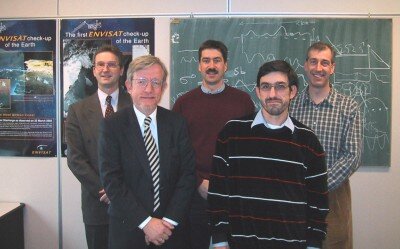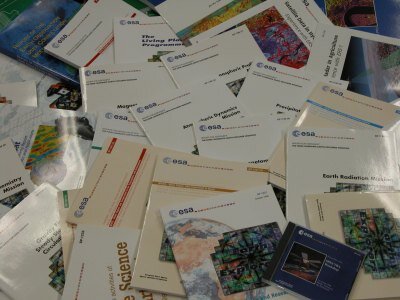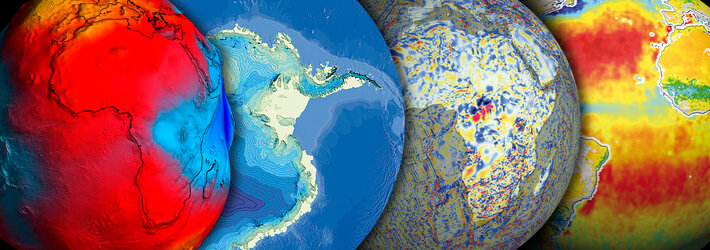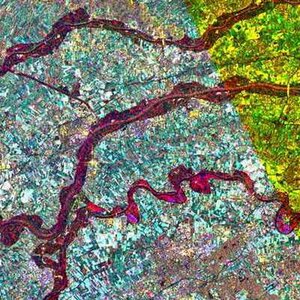ESA’s Earth Sciences Division celebrates 10 year anniversary
On Friday 29 November, glasses were raised to toast ESA’s Earth Sciences Division’s 10th anniversary. The Division currently plays a crucial role providing scientific support for the Living Planet Programme as well as other ESA Earth Observation projects. However, although the Division’s achievements during the last 10 years are without doubt cause for celebration, the Directorate is currently undergoing a reorganisation and this may have an impact on the future role of the Division.
The Earth Sciences Division was originally devised back in the late 1980’s when it was recognised that ongoing projects in Earth Observation were in need of scientific support to ensure that the Earth Observation scientific community became fully involved in the selection process of future missions. In order to fulfil this requirement, the Earth Sciences Division was officially founded in 1992 and Chris Readings relocated from ESA Paris to ESTEC in the Netherlands to take up the position of Head of Division. Reporting to Prof. Philip Goldsmith, Director of Observation of the Earth and its Environment, the main function of the Division was to maintain contact with the scientific communities in the fields of Atmosphere, Ocean and Ice, Land Surface Processes and Solid Earth and advise on the interests and aspirations of the various interested communities. In addition, the Division was to provide scientific support to mission managers and projects in Earth Observation such as Meteosat, ERS-1 and ERS-2, establish science advisory groups for the Directorate as well as carry out external and internal research studies.
Up until then, Earth Observation projects had been in the hands of very competent engineers but having this bunch of ‘weird scientists’ now influencing mission requirements certainly took some getting used to. Being a fervent Shakespeare fan, the very British Chris Readings on occasion likened his Earth Sciences Division to ‘Us few’, alluding to Henry V at the Battle of Agincourt. Life though was never really as bad as all that, and friendly friction very soon lead to fruitful collaboration as well as a large scientific community who supported ESA’s Earth Observation satellites.

Between 1992 and 1994 the team started to grow, albeit very slowly. Chris Readings and his secretary Drusilla Wishart were joined by Mike Rast (Land/Surface Processes) and several months later by Paul Ingmann (Atmosphere). 1994 saw the start of the Ocean/Ice Unit when Johnny Johannessen joined ESA from NERSC, although Mark Drinkwater now heads this Unit. The Campaigns Unit was also started – at first unofficially as Evert Attema was still with Envisat occupied a vacant office in the Division, but soon the ruling ‘possession is nine-tenths of the law’ came into play and the Earth Sciences Division acquired a Campaigns Unit. More recently, the Solid Earth Unit was established when Roger Haagmans joined the Division in 2001.
In 1994 almost 300 participants attended an Earth Observation User Consultation meeting in ESTEC, in which ESA’s strategy for future Earth Observation was reviewed. As a result of this meeting, the concept of the Earth Explorers research missions and the Earth Watch operational missions was formulated and is now the basis of the Living Planet Programme.
Although still a very small team, the Earth Sciences Division organised the first of the Earth Explorer Candidate Core Mission User Consultation Meetings in 1996 in Granada, where nine candidate missions were reviewed as part of the first round of the selection process for Earth Explorers. The second of the ‘Granada’ meetings in 1999 turned out to be a bit nerve racking though as much of the presentation material for the meeting, attended by 250 people, was accidentally shipped to Grenada in the Caribbean rather than to Granada in Spain. Nevertheless, after a bit of a panic the meeting went on and the Earth Sciences Advisory Committee recommended to the PB-EO that GOCE and ADM-Aeolus be selected as the first two Explorer Core missions. As a result, GOCE is currently in Phase C/D and ADM-Aeolus is now undergoing Phase B. Following the third ‘Granada’ meeting held in 2001, EarthCARE, SPECTRA and WALES were selected and are currently being studied at Phase A. These studies are due to be completed in the latter half of 2003 and the next User Consultation Meeting is planned for 2004. It was at one of these meetings that the Director of the World Climate Research Programme referred to the Earth Sciences Division as the Delta Force of Remote Sensing – obviously a force to be reckoned with!
In 1999 the Opportunity missions CryoSat and SMOS were selected and progress is now well underway – CryoSat is due for launch in 2004 and SMOS in 2006. Also, this year SWARM, ACE+ and EGPM were selected to undergo Phase A study.

The concept of the Living Planet Programme was formulated some years ago under the guidance of the Director of Science Prof. Roger Bonnet and Prof. Gerard Megie, Chairman of ESAC at the time. In 1998 the ESAC played a major role along with the rapidly growing Earth Sciences Division in the production of the document ‘The Science and Research Elements of ESA’s Living Planet Programme’ (SP-1227). Now under the leadership of Einar-Arne Herland a former Programme Board Delegate, the Division still refers to this document as their ‘bible’. The Division however, is no stranger to producing excellent publications – in fact they have been termed ‘the biggest paper producer in the Agency’, having published over 55 ESA reports, amounting to a staggering 60 tonnes of paper.
Although a huge chunk of work has been invested in the Earth Explorer missions, work still continues on the programmes already up and running, namely ERS-2, Envisat, MetOp and MSG – all now successfully launched and producing data.
Today, the future of the Earth Sciences Division appears to be somewhat uncertain, but after all where would the Agency be without perpetual reorganisations? In the past the Division has come under different Directorates – Earth Observation, Telecom and even Space Science and is now on the brink of making another transition from Future Programmes to the Science and Applications Department. However, it will be the first time in 10 years that Division will probably have to undergo a name change - bets are currently being taken on what their new name will be! Regardless of this impending change, the Division is still backed by more than 200 supportive external scientific advisors and the Earth Observation user community at large, all involved in the decision-making processes via various conferences, workshops and science studies. Without them the Earth Sciences Division would never have come this far – therefore, ‘our success is their success too’. So, with a 10-year history of success behind them the Earth Sciences Division’s anniversary really is a cause for celebration rather than a reason to mourn – Happy 10th Birthday ESD!





